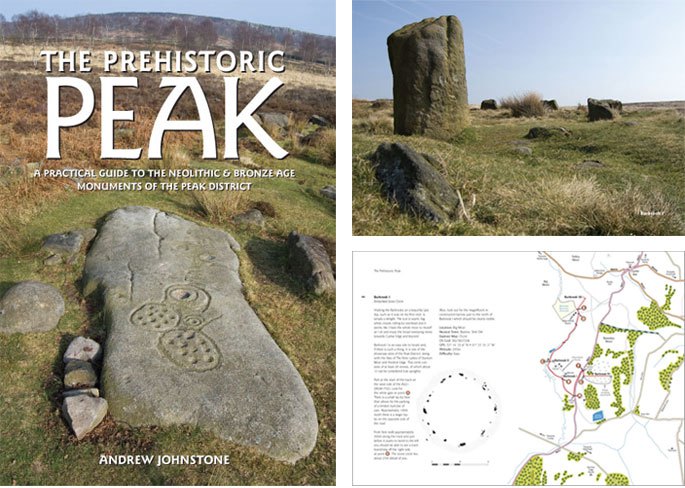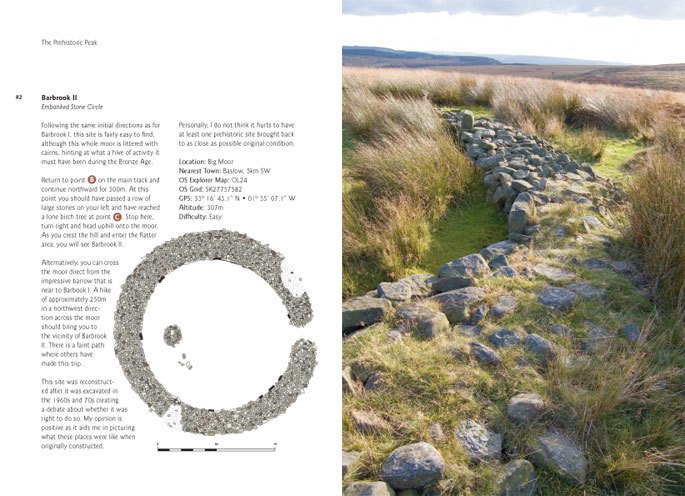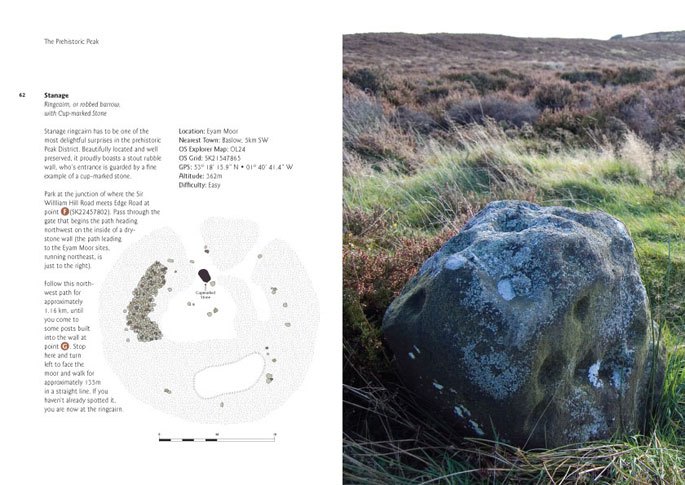A Practical Guide to the Neolithic & Bronze Age Monuments of The Peak District
Written and designed by Andrew Johnstone
England’s Peak District National Park is renowned for its dramatic landscapes and outstanding natural beauty. Scratch below that surface and the visitor can also find and area steeped in thousands of years of mankind’s history. After the ice sheets retreated 10,000 years ago, man returned to the area to hunt and gather, then as the establishment of farming began and those nomadic groups began to settle and cultivate the land, they also began to mark this land with megalithic monuments of all shapes and sizes, many of which can still be seen today.
The Prehistoric Peak is a practical guidebook to discovering and exploring the Neolithic and Bronze Age monuments of the Peak District. The intention is not to explain their origins, but to encourage everyone to go and see them for themselves as they are today. After all, they are located in some of the most spectacular landscapes available to us in Britain today and make fascinating destinations for journeys that are about experiencing all the wonders of the world around us.
I have visited each site several times in order to record each one through photographs, ground plans of what can be seen today, custom maps with step-by-step, clear, concise directions on how to find each one and all the necessary GPS and OS grid references.
It also includes practical advice on how to make your exploration of the Prehistoric Peak as pleasurable and safe as possible as well as a comprehensive list of all other known sites in the Peak District along with their OS grid reference.
Specifications
ISBN 978-1-4466-3902-3
192 pages
Perfect-bound paperback
Full colour throughout
14.5 cm x 21.0 cm
£20.00
Special offer £18.00 + P&P!



What others are saying about ‘The Prehistoric Peak’
“Every so often, an unexpected gem crosses our desks at CA. The Prehistoric Peak is the latest of these happy occurrences. This book is a step-by-step guide of the author’s own journey to each of the 52 featured sites.
The author’s casual curiosity developed into a passion for, British prehistory. Neither historian nor archaeologist, Johnstone produced this book for a graduate design course at Central St Martins. The end result is an absolutely gorgeous, easily digestible volume packed with practical tips, packing lists, basic introductions to time periods and monuments, colour photographs, and finally – the monument guides.
There are many people who struggle with map reading, and may be discouraged from visiting sites for this very reason. The maps and monument plans take the mystery and struggle out of this process. Colourful, highly accurate, detailed yet simple, easy to read and understand: truly a resource that puts the visitor in the picture. There is also explanatory text about walking conditions and what to expect, and standard information for each monument — including nearest town, OS map reference, as grid number, GPS data, altitude, and a difficulty rating.”
—Review by LWW
REVIEW BY JULIAN COPE ON HIS MONTHLY ‘ADDRESS DRUDION’, HEADHERITAGE.CO.UK, OCTOBER 2011
Finally, I’d like to embark on a chant of ‘Motherf***er! Motherf***er! Motherf***er!’ to author Andrew Johnstone, whose exceptional book THE PREHISTORIC PEAK has, in just under 200 pages, damn near exhaustively described all of those mysterious and much battered ancient megalithic monuments located in that weird triangle between Manchester, Sheffield and Ashbourne. Having taken exceptional pains to visit monument sites even where all remains had been removed, Andrew Johnstone has finally pulled aside the Information Smog which had, for far too long, hung, across this quite remote area.
Relatively small (easily overthrown) family-sized megalithic monuments, remote rural locations, constant inundation by tenacious moorland vegetation, indeed umpteen Problems of the Peak had, these past few decades, managed to thwart any author who attempted to add to John Barnatt’s bold, hefty 1960s-70s contributions. But with the arrival of this handsome field guide THE PREHISTORIC PEAK, which exhibits full colour photographs and highly detailed colour maps throughout, and which courteously even prepares readers for disappointment, should a too-destroyed site not remain worth visiting to many, Andrew Johnstone has stepped up into a different league of achievement.
At £26, this is not an inexpensive book but is what I believe we all should be expecting to pay in return for fastidious fieldwork and direct new information of this rigorous calibre. So do buy this book all you Kinder Scouts and Derbyshire scramblers round the Devils’ Arse or thereabouts. O, and did I not mention? As Common Era, Andrew Johnstone is also a member of the Black Sheep. Right fucking on, sir! So readers visit click here to secure your own copy, brothers’n’sisters … and pronto, Tonto.
—Review by JC
